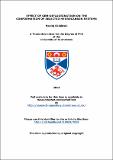Files in this item
Effect of gem-difluorination on the conformation of selected hydrocarbon systems
Item metadata
| dc.contributor.advisor | O'Hagan, David | |
| dc.contributor.author | Skibiński, Maciej | |
| dc.coverage.spatial | 195 | en_US |
| dc.date.accessioned | 2015-07-28T14:43:43Z | |
| dc.date.available | 2015-07-28T14:43:43Z | |
| dc.date.issued | 2014-06-25 | |
| dc.identifier.uri | https://hdl.handle.net/10023/7058 | |
| dc.description.abstract | Owing to its unique electronic properties, the CF₂ group has the potential to affect the conformation and polarity of molecules. The Introduction provides an overview of the conformational effects induced by the incorporation of fluorine into hydrocarbons, e.g. gauche effect, 1,3-C,F bond repulsion and angle deviation in organofluorine compounds. A summary of synthetic strategies for the introduction of the gem-difluoride motif into organic molecules is also presented. In order to explore the conformational impact of the CF₂ group in alicyclic hydrocarbon systems, cyclododecane was employed as the molecular framework. In 1,1,4,4- and 1,1,7,7- tetrafluorocyclododecanes, two CF₂ groups replaced CH₂ units within the square [3333] cyclododecane ring where the spacing enables the CF₂ groups to occupy adjacent or opposite corner locations. In the case of 1,1,6,6-tetrafluorocyclododecane, one of the CF₂ groups was forced to the edge position, which changes the ring conformation dramatically. Strategic incorporation of two CF₂ groups is shown to either stabilise or significantly alter the conformation of the cyclododecane framework, a revealing conformational preference of the CF₂ group to locate at the corner rather than the edge position of hydrocarbon rings. The study extends to larger cycloalkanes, rectangular [3434] cyclotetradecanes and square [4444] cyclohexadecanes. The target cycloalkanes bearing two CF₂ units were assembled through a novel synthetic route, employing ring-closing metathesis (RCM) as the key step. X-Ray structure analyses revealed that the CF₂ groups occupy exclusively corner locations of these rings too. The spacing between the CF₂ moieties dictates the overall ring conformations and offers a useful tool for controlling molecular arrangement. An accelerating role of the CF₂ group, relative to the CH₂ group, on the ring-closing metathesis of C5-substituted 1,8-nonadienes has also been studied. Remarkably, the CF₂ group exhibited a similar reaction rate to that observed for nonadienes bearing 1,3-dioxolane or dimethylmalonate groups. This effect was rationalised by the thermodynamic stability of the cycloheptene products, rather than a Thorpe-Ingold effect. | en_US |
| dc.language.iso | en | en_US |
| dc.publisher | University of St Andrews | |
| dc.subject | Gem-difluoromethylene group | en_US |
| dc.subject | Gem-difluorination reactions | en_US |
| dc.subject | Conformational effects | en_US |
| dc.subject | Cycloalkanes | en_US |
| dc.subject | Ring-closing metathesis | en_US |
| dc.subject | Thorpe-Ingold effect | en_US |
| dc.subject.lcc | QD412.F1S6 | |
| dc.subject.lcsh | Fluorohydrocarbons--Conformation | en_US |
| dc.subject.lcsh | Fluorination | en_US |
| dc.subject.lcsh | Cycloalkanes | en_US |
| dc.subject.lcsh | Metathesis (Chemistry) | en_US |
| dc.title | Effect of gem-difluorination on the conformation of selected hydrocarbon systems | en_US |
| dc.type | Thesis | en_US |
| dc.contributor.sponsor | European Research Council (ERC) | en_US |
| dc.type.qualificationlevel | Doctoral | en_US |
| dc.type.qualificationname | PhD Doctor of Philosophy | en_US |
| dc.publisher.institution | The University of St Andrews | en_US |
This item appears in the following Collection(s)
Items in the St Andrews Research Repository are protected by copyright, with all rights reserved, unless otherwise indicated.

